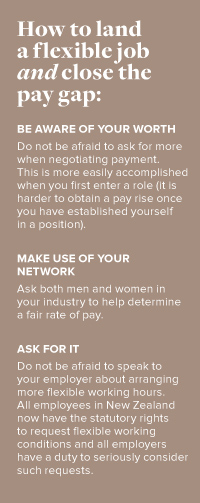Balancing Act
Ever since women started working outside the home, the glass ceiling has dominated discussions of success. In the past, advice given to women looking to move past this invisible barrier and progress their career was often centred on them adapting their behaviour to suit the workplace. Now, however, experts are putting the onus on workplaces changing their structures to better suit female employees.
Somewhat obvious and perhaps overlooked, the concept that women (particularly those with the added responsibility of having a family) need more flexible roles is a simple one. On the surface, a better work/life balance appears to benefit both employees and employers, with research indicating happier employees are also the most productive. Today, more companies than ever before are adopting this attitude, in the hopes of boosting both profits and the careers of female employees.
And, if government advice is anything to go by, it may just be part of the solution working women have been hoping for. Both here in New Zealand and in the United Kingdom, government organisations have announced their support for more flexible working arrangements for women. While the British government recently announced that flexible working is crucial for closing the gender pay gap, the Ministry for Women in NZ has stated it is likely to reduce barriers experienced by working mothers. Whether this means variable start and finish times, working fewer days or working from home, working arrangements allow more women to attend to their family life. Given about one-third of New Zealand female employees work part-time, the promotion of flexible working arrangements could very well make a dent in the gender pay gap.
One company in New Zealand already offering flexible working terms is Microsoft. While not specifically intended for women only, Microsoft’s new leave benefits offer a generous amount of time for employees to spend with their loved ones. All employees are eligible to take leave as soon as they begin a role with the company. This includes four weeks’ paid leave per year at 100 percent of their salary to take care of ill family members as well as extensive leave for parents. In addition to offering 20 weeks leave to primary caregivers, secondary caregivers can also take up to six weeks off at 100 percent of their salary per year. This offer also extends to adoptive and foster parents.

Ebeny Kurz-Firth, Microsoft New Zealand’s HR Lead, says their new policy is to the benefit of all employees, not just women. “Possibly more traditionally, women do tend to be the primary caregiver when it comes to either having time out of the workplace to raise children or taking care of sick family members,” she says. “However, the intent behind our policies is that everyone should feel they have the equal opportunity and support from the company to take time out, when they need it the most.”
Indeed, it’s little wonder why more companies are interested in offering flexible working arrangements when research continually shows happy employees are the most productive. According to the latest research by the University of Warwick in Britain, happy people are more productive because they are more effective with their time and are able to increase the pace at which they work without they quality of their work suffering. This is not the only study to suggest happier employees with a good work/life balance are better at their jobs.
While on the surface flexible work may seem beneficial to employees and employers alike, this is not to say flexible working terms for women does not have its problems. “The challenge is making sure that flexible working hours don’t act as a barrier to women’s career aspirations and wage progression,” says Margaret Retter, acting chief executive at NZ’s Ministry for Women. According to research by the ministry, there are few roles with higher skill levels and pay that are available part-time. This can lead to women trading down their skills to gain flexible employment. Moreover, the organisation also found that working long hours in certain industries such as accounting or engineering, tends to be required in order to progress to senior roles.
Even in workplaces with flexible roles available, women taking part in them can be viewed negatively and be seen as being on the ‘mummy track’ as well as career limiting. Moreover, both male and female employees interviewed across a variety of accounting and engineering firms by the ministry in 2010 believed that looking after children and taking on the role of a partner in the firm are mutually exclusive – in other words, it is not possible to do both due to the demands of each role.

Like the ministry’s research, Harvard economist Claudia Goldin highlights a major flaw with the ideology that flexible work can single-handedly close the gender gap. According to the economist, a major contributor to the pay gap seems to be the difficulty of securing a substantial income. However, as major companies like Microsoft begin to acknowledge the need for well-paid, extensive leave (particularly for new mothers and parents), other employers may soon take notice. As Retter of the Ministry for Women NZ notes, normalising flexible work options is a step in the right direction. “This [flexible work] helps attract and retain people and reduces the risk that working flexibly (particularly part-time) will hinder career advancement.”
Likewise, the acting chief executive also says it’s important for flexible work to be embraced by both male and female employees, as at Microsoft. “This benefits everyone: child, father and mother, as parenting responsibilities often fall unequally on working mothers.” Indeed, while it may not be a quick fix for closing the gender gap or breaking the glass ceiling, flexible work can still offer some hope for working women struggling to find balance.
This article was featured in the July/August 2017 issue of M2woman Magazine.

